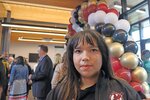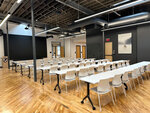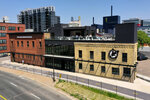


The newly open Red Lake Nation College in downtown Minneapolis is one of the first tribal colleges in a major U.S. city and is reaching a “never-served” community,” according to Dan King, Hereditary Chief at Red Lake Nation and President of Red Lake Nation College (RLNC).
“Our grand opening represents a significant step towards providing accessible education to Native American communities living in urban areas,” said King. “By establishing our Minneapolis location, we are pioneering a new era of tribal college presence in major metropolitan centers, offering globally relevant courses steeped in Ojibwe culture to prepare students for success in the modern job market.”
Close to the Franklin/Lake St. Native community, the Minneapolis campus at 900 S. 3rd St. across from the U.S. Bank Stadium is near bus and lightrail lines. The new facility is a blend of old and new, in keeping with the RLNC vision of honoring and adapting. Two 1905 brick buildings are joined together with a new addition that features the same graphite siding as the U.S. Bank Stadium. The original wood floors were preserved, and the brick and timber highlighted. New large, storefront glass windows were installed, along with new wood glulam ceilings. The architect on the project was Sam Olbekson of Full Circle Indigenous Planning, an enrolled member of the White Earth Nation of Ojibwe.
Construction occurred from April 2023 to April 2024. The tribe paid $4.2 million for the three buildings, and another $12 million for the renovation. The $16.2 million facility is fully paid off. Native-owned Loeffler Construction oversaw the project. RLNC expects to earn revenue through rentals based on their prime location and rooftop views.
According to Minnesota Compass, 44.2% of Minnesota’s American Indian population resides in the Twin Cities, yet until now, there was no TCU (Tribal College and University) in the cities that provided culturally-based higher education. RLNC began offering courses through distance education in downtown Minneapolis in fall 2021.
“It’s not an under-served community. It’s a never-served community,” said King during the grand opening on Thursday, June 6, 2024.
Culturally based
“I had been looking for something that was more culturally based,” said Marissa Martin, who lives in the Como neighborhood of St. Paul near the State Fairgrounds. She had considered other options in the Twin Cities around where she grew up, as well as going to the Red Lake Nation College campus in Red Lake. But she didn’t necessarily want to move and was glad to be able to attend a tribal college near her home when she enrolled last year.
She appreciates the course offerings in Indigenous knowledge and small class sizes. It’s also valuable to her to be taking classes with other Indigenous students who have similar goals and to be taught by Indigenous teachers, she said. “Culture is embedded in everything we’re learning,” stated Martin. “It all comes down to identity and feeling really safe here.”
A place she found herself
Minneapolis resident Eliza Washington lives in Mino-Bimaadiziwin Apartments – a multi-use, affordable housing complex in Minneapolis developed by Red Lake Band of Chippewa Indians at 2107 Cedar Ave. She was the second person to move in there, and that’s how she heard about the new RLNC campus. She started taking online classes in the spring of 2022 when the Minneapolis location was occupying one building. “It’s been kinda neat to watch it unfold,” Washington said. One year previously, they had stood there with a pile of shovels as the project to renovate and unite the two buildings began. She was part of brainstorming sessions to discuss what they wanted in the college campus building. The new campus is bright and open, with natural light from windows with scenic views of downtown. There are indoor and outdoor spaces to study and learn. It has the latest in technology with multiple screens in various rooms.
Washington grew up in Duluth, graduated from a public non-tribal high school in 1996, and moved to the Twin Cities in 2006. She attended Lake Superior College and checked out Fond du Lac Tribal and Community College in Cloquet, but she didn’t have the same experience at those two schools as she has at RLNC. “Here I feel like I’m more seen, hear and valued. It’s like a family feel here,” said Washington, who is part of the Leech Lake Band of Ojibwe.
She values the Native history and Native language that are part of the core curriculum at RLNC. It’s the first time she has learned these subjects in a school setting. “It gave me a place to find myself and learn about myself, my history and where I come from,” she remarked. “They don’t teach you that stuff in mainstream schools.”
Washington is also part of the staff at RLNC, working full-time as an business office specialist. “They like to grow their own,” she observed. She has two classes left before she graduates with an associate of arts degree in tribal education.
Initially, Washington was worried about going back to school in her 40s, but she found a student body made up of people ages 20 to 50. “There’s a good group of us. We all hang out together,” she observed. The student body is expected to grow from 100 to 180 for the 2024-2025 school year now that the construction project is complete.
73 percent of staff IS Indigenous
Red Lake Nation College (RLNC) was established in 2001 to serve the Red Lake Nation in Red Lake, Minn. Red Lake Nation College offers a range of certificate and academic degree programs designed to empower students and strengthen the Red Lake Nation community in a higher education environment that honors students’ Indigenous identities.
About 80 percent of the students at RLNC are first-generation college students. Over 73 percent of staff and faculty are Native. The school seeks to serve students anywhere – which includes a HyFlex option that gives students the ability to attend remotely.
RLNC welcomes students of all tribal backgrounds through its open-enrollment policy.
Their “secret sauce” according to King is small class sizes, personalized, one-on-one attention, intrusive counseling, family connections with students, a Native perspective stemming from the seven Ojibwe values, mentorship and role modeling, and a support system that includes tutoring, counseling, emergency funds and food.
The school is experiencing a 35-40 percent increase in enrollment each year.
RLNC has earned the highest level of accreditation in the United States through the Higher Learning Commission. It involved a 10-year, $15 million investment. This means that RLNC meets the same academic standards as other major universities, including the University of Minnesota, Purdue University and the University of Michigan. Through academic partnerships, there is an ease of transfer with no cost for RLNC students to transfer to all MNSCU schools and articulation agreements with other four-year universities such as Augsburg University.
RLNC students typically leave with zero debt as there are no loans, only grants. All students receive a tech backpack with a computer and internet access. The average debt load for a two-year college graduate is $33,000.
RLNC two-year graduate rates are at 45 percent – which is at or near the top 10 percent in the U.S. for two-year colleges.
Students are graduating at the highest rates ever and graduates are transferring to the University of Minnesota, Bemidji State University, Metro State, Augsburg and even Dartmouth.
“Our motto is ‘we’re a great place to start,’” stated King.
Comments
No comments on this item Please log in to comment by clicking here